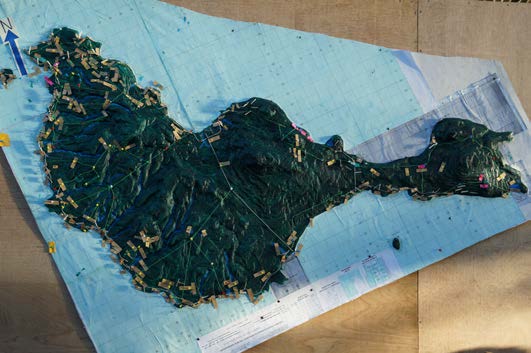A study of the Samoan experience of participatory three-dimensional modelling (P3DM), a practice which has been widely promoted by CTA, has shown that it has led to better natural resource management, helped local communities become more resilient to climate change and brought about significant changes in the relationship between governments and local communities.
P3DM is a mapping progress which enables local communities to ‘populate’ geo-referenced relief models with their own knowledge about physical features, such as rivers and villages, and the way in which their territory is used, for example for hunting, fishing and growing crops. The maps help to enhance a sense of belonging and local knowledge and many communities have used them to assert their rights, identify resources and opportunities, and devise new strategies for managing the land.
Giacomo Rambaldi, who has led CTA’s work on P3DM, was contacted in 2016 by Barbara Dovarch, a PhD candidate from the University of Sassari, Italy. She was keen to look at the effectiveness of P3DM and Rambaldi suggested she carry out her fieldwork in Samoa. Here, a 5-year project funded by the Global Environment Facility and carried out by the Samoan Ministry of Natural Resources and Environment, had used P3DM to sensitise local communities to climate change. Rather than being initiated by the local communities and their partners, as normally happens, P3DM was introduced by a government department as a way to reach communities and gain their trust.
Dovarch found that prior to the introduction of P3DM, community representatives tended to adopt a very passive attitude during consultations with the authorities. “Government officials usually adopted a lecturing style in meetings with community members, using PowerPoint presentations and information leaflets, often without success,” noted Dovarch in her report. However, the P3DM process provided local communities with the opportunity to express their own understanding about their land and take a more active role in resource management. The building of the models also enabled young and old people to talk to one another and exchange knowledge about nature, culture and history.
According to community members who spoke to Dovarch, the process encouraged the government to change the way it behaved towards local people. Now it is much more willing to ‘listen’ rather than ‘teach’. Government officials moved away from ‘consultations’ towards active participation, which helped to build trust on both sides. As far as the government officials were concerned, the P3DM process – in Dovarch’s words – “completely changed the attitude and approach of communities towards their own environment and land management.”
The government of Samoa was initially exposed to P3DM techniques through CTA’s ICT4Ag activities. Since then, it has not only contributed to the development of 19 P3DM models over a 4-year period, but also committed itself to playing an important role in popularising the technique in other parts of the Pacific region, beginning with Tonga. Dovarch described her findings in a CTA working paper in the ICTs for agriculture series, Participatory 3D modelling in Samoa: Triggering behavioural changes in climate change resilience.
P3DM is a mapping progress which enables local communities to ‘populate’ geo-referenced relief models with their own knowledge about physical features, such as rivers and villages, and the way in which their territory is used, for example for hunting, fishing and growing crops. The maps help to enhance a sense of belonging and local knowledge and many communities have used them to assert their rights, identify resources and opportunities, and devise new strategies for managing the land.
Giacomo Rambaldi, who has led CTA’s work on P3DM, was contacted in 2016 by Barbara Dovarch, a PhD candidate from the University of Sassari, Italy. She was keen to look at the effectiveness of P3DM and Rambaldi suggested she carry out her fieldwork in Samoa. Here, a 5-year project funded by the Global Environment Facility and carried out by the Samoan Ministry of Natural Resources and Environment, had used P3DM to sensitise local communities to climate change. Rather than being initiated by the local communities and their partners, as normally happens, P3DM was introduced by a government department as a way to reach communities and gain their trust.
Dovarch found that prior to the introduction of P3DM, community representatives tended to adopt a very passive attitude during consultations with the authorities. “Government officials usually adopted a lecturing style in meetings with community members, using PowerPoint presentations and information leaflets, often without success,” noted Dovarch in her report. However, the P3DM process provided local communities with the opportunity to express their own understanding about their land and take a more active role in resource management. The building of the models also enabled young and old people to talk to one another and exchange knowledge about nature, culture and history.
According to community members who spoke to Dovarch, the process encouraged the government to change the way it behaved towards local people. Now it is much more willing to ‘listen’ rather than ‘teach’. Government officials moved away from ‘consultations’ towards active participation, which helped to build trust on both sides. As far as the government officials were concerned, the P3DM process – in Dovarch’s words – “completely changed the attitude and approach of communities towards their own environment and land management.”
The government of Samoa was initially exposed to P3DM techniques through CTA’s ICT4Ag activities. Since then, it has not only contributed to the development of 19 P3DM models over a 4-year period, but also committed itself to playing an important role in popularising the technique in other parts of the Pacific region, beginning with Tonga. Dovarch described her findings in a CTA working paper in the ICTs for agriculture series, Participatory 3D modelling in Samoa: Triggering behavioural changes in climate change resilience.













.JPG)

.jpg)
.JPG)
.JPG)





.jpg)
.JPG)
.jpg)
.jpg)



